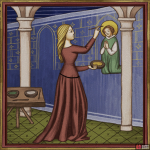Text
The work of painters until the late Middle Ages primarily involved skillfully executing commissioned works, rather than expressing the artist’s personal vision. While they could decide on the technique of creation, they had little influence over the subject, colours, or size of the commissioned artwork.
Apart from commissions for large-scale murals in sacred or ceremonial spaces, most painters devoted themselves mainly to decorating wooden furniture, ceilings and even weapons. The most esteemed painters could showcase their skills in altar paintings. Classical canvas paintings, as we know them today, were rare until the end of the 14th century and served more as a display of wealth than for decorative purposes.
Paintings were often created in painters’ workshops under the supervision of a master and involved the work of several painters, who specialized in different parts of the paintings - figures, ornaments, animals, backgrounds, etc. Painting was seen more as a collaborative craft than an individual artistic endeavor.
As a result, the names of specific artists from early paintings are largely unknown. Although the first signatures appear in Italy as early as the 12th century, they did not become common in central Europe until the turn of the 14th and 15th centuries. Therefore, to distinguish the prominent artists of Czech medieval paintings, auxiliary names referring to the places where their works were preserved are used, such as Master of the Vyšebrod Altar, Master of the Třeboň Altar or Master of the Litoměřice Altar.
The names of the many monk-artists who created the carefully crafted and exuberant illuminations in contemporary books and manuscripts, will unfortunately never be known again.


No Comments